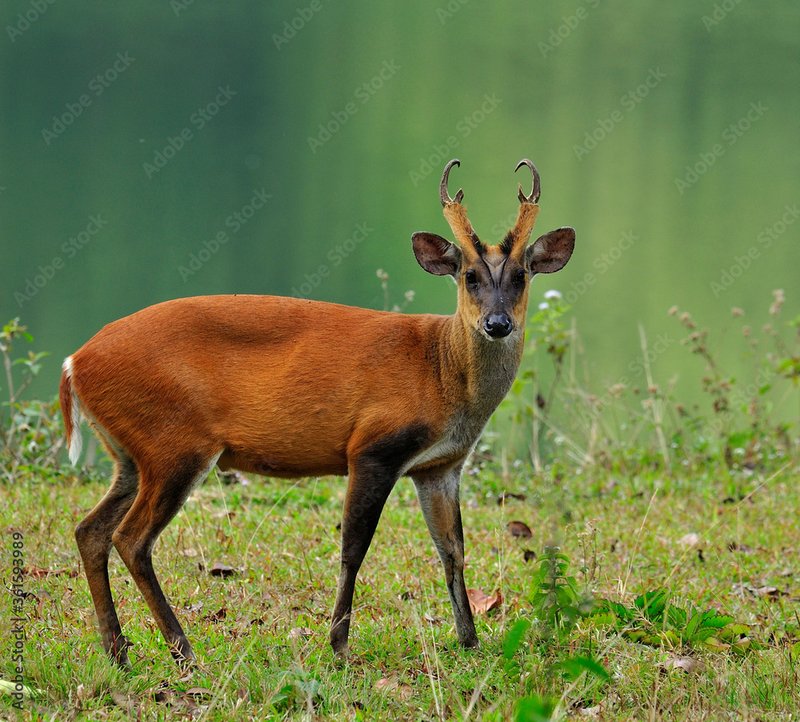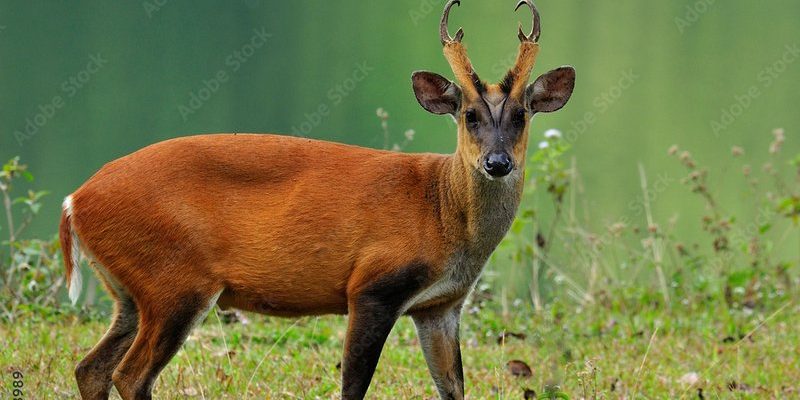
The Indian Muntjac, often called the barking deer, is a fascinating creature that roams the forests of South and Southeast Asia. Imagine a small, nimble deer that can hide effortlessly in the underbrush, using its size and agility to escape from predators. This captivating animal stands out not just because of its unique vocalizations but also due to its distinct physical traits and behaviors. It’s easy to see why the Indian Muntjac has captured the interest of wildlife enthusiasts and researchers alike.
You might be surprised to learn that these deer are quite versatile. Depending on the environment, they can be found in various habitats, from dense jungles to fragmented forests. Their adaptability is one of the many things that make them special. So, if you’re curious about the Indian Muntjac, its characteristics, habitat, diet, and behavior, settle in — there’s a lot to explore!
Physical Characteristics
When it comes to physical traits, the Indian Muntjac is quite distinct. They typically stand about 60 to 90 cm tall at the shoulder, with males larger than females. Their coat is usually a reddish-brown or yellowish-brown, which helps them blend into their forest environment. As they mature, males develop small, spikes-like antlers that can grow to about 20 cm long, which they shed annually. These antlers are often used in social displays during mating season.
One of the most notable features of the Indian Muntjac is its face. With large, expressive eyes and a somewhat elongated snout, they have a look that could easily draw you in. Their ears are big and quite mobile, allowing them to detect sounds in their surroundings effectively. The Indian Muntjac’s legs are slender and strong, enabling them to navigate through thick vegetation with ease.
These deer also have a unique adaptation — their ability to vocalize. Their distinctive barking sound can often be heard echoing through the forests, especially during mating season or when a potential threat appears. It’s a sound that’s hard to forget and adds to their charm.
Habitat and Distribution
Indian Muntjacs are primarily found in the dense, tropical forests of India, Nepal, Bhutan, Bangladesh, Myanmar, and parts of Southeast Asia. They prefer habitats that provide cover, which helps them evade predators such as leopards and wild dogs. You can often find them in areas with thick underbrush or near water sources, where they can easily access food and shelter.
These deer can adapt to varying altitudes, living from sea level up to about 2,000 meters in the Himalayas. Their ability to thrive in mixed forests and even agricultural areas means they can sometimes coexist near human settlements. However, habitat loss due to deforestation and urban development is a growing concern for their populations.
The Indian Muntjac is not a solitary creature; they often live in small groups or family units. These groups usually consist of a dominant male, a few females, and their young. This social structure helps them thrive in their preferred habitats and maintain stability within their population.
Diet and Feeding Habits
The Indian Muntjac is primarily herbivorous, feeding on a variety of plant materials. Their diet typically includes leaves, fruits, flowers, and grasses, which they forage in their natural habitats. Thanks to their keen senses, these deer can often find nutritious plants even in dense undergrowth. This ability to adapt their diet based on the seasons is crucial for their survival.
What’s interesting is that Indian Muntjacs are known to be selective feeders. They often choose tender leaves and new growth, which provide the most nutrients. This behavior is vital in ensuring they get a balanced diet, especially during challenging seasons when food sources may become scarce.
Another fascinating aspect of their feeding habits is their ability to browse during both day and night. This flexibility allows them to evade predators while still obtaining the necessary nutrition. So, if you find yourself in their habitat, be on the lookout — you might spot one nibbling on a nearby shrub!
Behavior and Social Structure
The Indian Muntjac is known for its intriguing social behaviors. They often communicate through a variety of sounds, including the iconic barking that gives them their nickname. This vocalization serves different purposes, such as signaling danger or attracting a mate. In fact, during mating season, males can be quite vocal, creating an orchestra of sounds that fill the air.
These deer are generally more active during the early morning and late afternoon, a behavior known as being crepuscular. This active time allows them to forage while avoiding the heat of midday. You might be wondering how they manage to stay safe from predators while foraging. Well, these little guys are great at using cover and maybe even staying still when they sense danger, making it difficult for predators to spot them.
In terms of their social structure, Indian Muntjacs typically live in small family groups. These groups are often led by a dominant male, with females and offspring in tow. The males are quite territorial, marking their surroundings with urine and feces to communicate with others. This territoriality becomes especially pronounced during mating season, as males compete for access to females.
Reproduction and Lifespan
When it comes to reproduction, Indian Muntjacs have an interesting breeding strategy. Females can mate year-round, but most births occur during the wet season when food is plentiful. After a gestation period of about seven months, a single fawn is born, which is typical for deer species. The fawn is usually hidden in thick cover for the first few weeks of its life to protect it from predators.
As the fawn grows, it begins to accompany its mother while foraging. It’s not uncommon for males to compete for access to females during the mating season. These competitions can involve vocalizations, displays of strength, and even sparring with their small antlers. It’s a natural way for the strongest genes to be passed on.
In terms of lifespan, Indian Muntjacs can live up to 10-15 years in the wild, although many face threats from predators and habitat loss. In protected environments, their lifespan can extend further. Understanding their reproduction and life cycle is essential for conservation efforts aimed at maintaining healthy populations.
| Characteristic | Details |
| Size | 60-90 cm tall at the shoulder |
| Weight | 20-40 kg |
| Diet | Herbivorous; consumes leaves, fruits, grasses |
| Habitat | Tropical forests, mixed woodlands |
| Predators | Leopards, wild dogs |
| Lifespan | 10-15 years in the wild |
Conservation Status
The Indian Muntjac, like many other wildlife species, faces challenges in terms of conservation. Habitat loss due to deforestation, urban expansion, and agricultural practices are significant threats to their populations. The fragmentation of their habitats often leads to isolated groups, which can decrease genetic diversity and increase vulnerability to changes in the environment.
In some areas, hunting has also posed a threat. Although it’s illegal in many regions, poaching for meat or to reduce competition with livestock is still a concern. Conservation efforts are underway in some parts of their range, focusing on habitat preservation and creating protected areas. These initiatives aim to ensure that future generations can enjoy the beauty of the Indian Muntjac just as we do today.
Many wildlife organizations are also working to raise awareness about the importance of preserving the natural habitats of this unique deer. Understanding and educating others about their role in the ecosystem can foster a sense of responsibility and care for these beautiful animals. So the next time you hear a bark in the woods, think of the Indian Muntjac and its vital place in the natural world.
FAQ
What is the Indian Muntjac’s primary habitat?
The Indian Muntjac thrives in tropical forests, mixed woodlands, and areas with dense underbrush. These habitats provide them with the necessary cover for foraging and hiding from predators. They can adapt to various elevations, from sea level to around 2,000 meters in the Himalayas.
How do Indian Muntjacs communicate?
These deer are known for their vocalizations, particularly a barking sound which serves multiple purposes. They use these sounds to signal danger, attract mates, and communicate with other group members. Their vocalizations can vary depending on the context and urgency.
What do Indian Muntjacs eat?
As primarily herbivores, Indian Muntjacs have a varied diet. They consume leaves, fruits, flowers, and grasses. Being selective feeders, they often seek out tender leaves and new growth, which offer the most nutrients. Their foraging behavior is adaptable and depends on the season.
Are Indian Muntjacs social animals?
Yes, Indian Muntjacs are generally social creatures. They often live in small family groups consisting of a dominant male, several females, and their young. This social structure can help them maintain stability and safety in their habitats.
What are the main threats to Indian Muntjacs?
The primary threats to Indian Muntjacs include habitat loss due to deforestation and urban development. Additionally, hunting and poaching for meat pose risks in certain regions. Conservation efforts are crucial to protect their habitats and ensure their populations remain stable.
How long do Indian Muntjacs live?
In the wild, Indian Muntjacs typically have a lifespan of about 10 to 15 years. However, in protected environments where they face fewer threats, their lifespan can be extended further. As with many wildlife species, various factors influence their overall health and longevity.
Can Indian Muntjacs adapt to different environments?
Yes, Indian Muntjacs are quite adaptable. They can thrive in diverse habitats, including agricultural areas and fragmented forests. Their ability to adjust their diet and behavior based on environmental changes plays a significant role in their survival.
Do Indian Muntjacs have any natural predators?
Yes, Indian Muntjacs have several natural predators, including leopards and wild dogs. Their small size and agility help them evade these threats, but they still face risks, especially from habitat loss and hunting.
What role do Indian Muntjacs play in their ecosystem?
Indian Muntjacs play an important role in their ecosystems as herbivores. By feeding on various plants, they help maintain the balance of their habitats and promote the growth of diverse vegetation. Their presence also supports the food chain by serving as prey for larger predators.
How can we help conserve the Indian Muntjac?
Conserving the Indian Muntjac involves supporting habitat preservation efforts and raising awareness about their plight. Getting involved with local conservation organizations, participating in habitat restoration projects, and educating others about wildlife conservation can make a significant difference.

